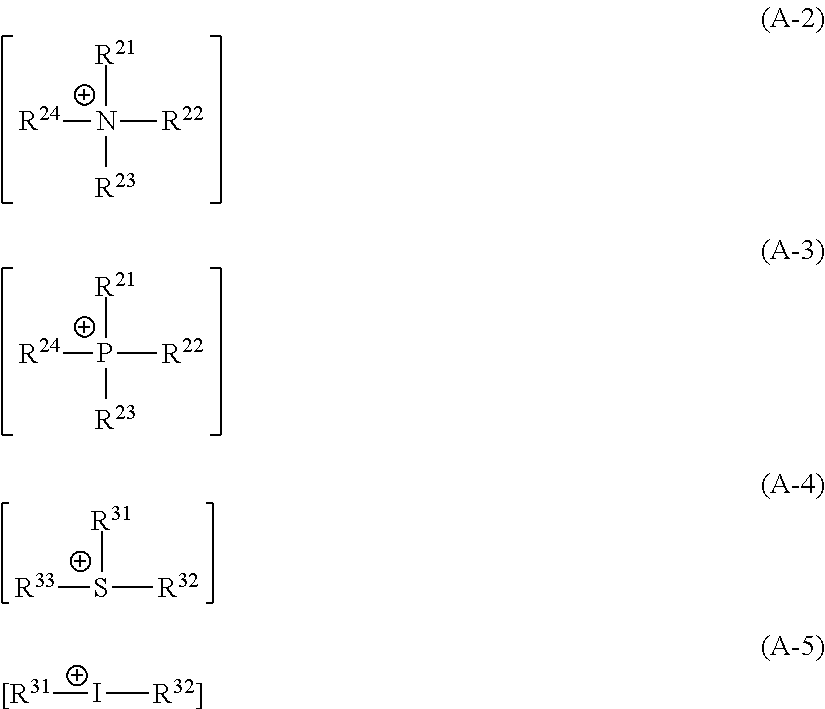Thermal crosslinking accelerator, polysiloxane-containing resist underlayer film forming composition containing same, and patterning process using same
a crosslinking accelerator and composition technology, applied in the direction of photomechanical equipment, group 3/13 element organic compounds, instruments, etc., can solve the problems of change of optical system, high cost of scanner, and extremely poor durability of soft pellicle, and achieve high etching selectivity, excellent adhesion, and high precision
- Summary
- Abstract
- Description
- Claims
- Application Information
AI Technical Summary
Benefits of technology
Problems solved by technology
Method used
Image
Examples
synthesis example 1
[0151]Into a mixture of 400 g of ethanol, 0.2 g of methanesulfonic acid, and 120 g of de-ionized water was added a mixture of 9.9 g of phenyl trimethoxy silane and 197.9 g of tetraethoxy silane; and then, the resulting mixture was kept at 40° C. for 12 hours to carry out the hydrolysis-condensation reaction. After completion of the reaction, 800 g of propylene glycol ethyl ether (PGEE) was added; and then, the bi-produced alcohols and excessive water were removed by distillation under reduced pressure to obtain 750 g of PGEE solution of Polysiloxane 1 (compound concentration of 11.5%). The polystyrene-equivalent molecular weight of this product was measured to be Mw=2550.
synthesis example 2
[0152]Into a mixture of 400 g of ethanol, 0.2 g of methanesulfonic acid, and 120 g of de-ionized water was added a mixture of 11.9 g of phenyl trimethoxy silane and 195.8 g of tetraethoxy silane; and then, the resulting mixture was kept at 40° C. for 12 hours to carry out the hydrolysis-condensation reaction. After completion of the reaction, 800 g of propylene glycol ethyl ether (PGEE) was added; and then, the bi-produced alcohols and excessive water were removed by distillation under reduced pressure to obtain 750 g of PGEE solution of Polysiloxane 2 (compound concentration of 11.7%). The polystyrene-equivalent molecular weight of this product was measured to be Mw=2500.
synthesis example 3
[0153]Into a mixture of 400 g of ethanol, 0.2 g of methanesulfonic acid, and 120 g of de-ionized water was added a mixture of 13.9 g of phenyl trimethoxy silane and 193.7 g of tetraethoxy silane; and then, the resulting mixture was kept at 40° C. for 12 hours to carry out the hydrolysis-condensation reaction. After completion of the reaction, 800 g of propylene glycol ethyl ether (PGEE) was added; and then, the bi-produced alcohols and excessive water were removed by distillation under reduced pressure to obtain 750 g of PGEE solution of Polysiloxane 3 (compound concentration of 11.5%). The polystyrene-equivalent molecular weight of this product was measured to be Mw=2500.
PUM
| Property | Measurement | Unit |
|---|---|---|
| wavelength | aaaaa | aaaaa |
| wavelength | aaaaa | aaaaa |
| wavelength | aaaaa | aaaaa |
Abstract
Description
Claims
Application Information
 Login to View More
Login to View More - Generate Ideas
- Intellectual Property
- Life Sciences
- Materials
- Tech Scout
- Unparalleled Data Quality
- Higher Quality Content
- 60% Fewer Hallucinations
Browse by: Latest US Patents, China's latest patents, Technical Efficacy Thesaurus, Application Domain, Technology Topic, Popular Technical Reports.
© 2025 PatSnap. All rights reserved.Legal|Privacy policy|Modern Slavery Act Transparency Statement|Sitemap|About US| Contact US: help@patsnap.com



